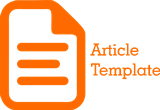Political communication of the Prime Minister of Malaysia Anwar Ibrahim on Twitter
Abstract
Globalisation, information, and communication technology have changed human communication. The internet gave birth to social media and a new communication trend. Digital, such as computer-mediated, communication replaces traditional communication. Face-to-face communication can now be done via social media, which blurs space and time. The benefit is that social media is not controlled by mainstream media, which decides what to publish. Social media lets any communication actor broadcast messages to the public at any time. Some communication actors are government officials, or political actors. Anwar Ibrahim, the prime minister, wants to build political trust and support through vertical and horizontal political communication. Anwar Ibrahim regularly uses Twitter to engage with residents, show his actions, and express his attitude, commitment, and government vision. Politicians must adjust to social media's power. This study uses Nvivo 12 Pro for social media analysis. According to Nvivo, Anwar Ibrahim's political communication concentrated on his actions, government matters, political affairs, and maintaining his relationship with citizens and the king.
Keywords
Full Text:
PDFReferences
Alim, A. S., & Rahmawati, D. E. (2021). Komunikasi Politik Anies Baswedan Melalui Sosial Media Twitter. Jurnal Academia Praja, 4(2), 441–453. https://doi.org/10.36859/jap.v4i2.334
Arrigo, E., Liberati, C., & Mariani, P. (2021). Social Media Data and Users’ Preferences: A Statistical Analysis to Support Marketing Communication. Big Data Research, 24, 100189. https://doi.org/10.1016/j.bdr.2021.100189
Aspers, P., & Corte, U. (2019). What is Qualitative in Qualitative Research. Qualitative Sociology, 42(2), 139–160. https://doi.org/10.1007/s11133-019-9413-7. https:// 10.3390/economies7010021
Bahrini, R., & Qaffas, A. A. (2019). Impact of information and communication technology on economic growth: Evidence from developing countries. Economies, 7(1), 21.
Baihaqi, A., Muksin, N. N., Harmonis, F., & ... (2022). Strategi Marketing Politik Bobby Nasution Dan Aulia Rachman Di Media Sosial Pada Pilkada Kota Medan 2020. Jurnal Ilmu …, 2(1), 1–14. https://jurnal.uss.ac.id/index.php/jikoba/article/view/361%0Ahttps://jurnal.uss.ac.id/index.php/jikoba/article/download/361/175
Fenton, A., Gillooly, L., & Vasilica, C. M. (2023). Female fans and social media: micro-communities and the formation of social capital. European Sport Management Quarterly, 23(2), 370–390. https://doi.org/10.1080/16184742.2020.1868546
Gil de Zúñiga, H., Koc Michalska, K., & Römmele, A. (2020). Populism in the era of Twitter: How social media contextualized new insights into an old phenomenon. New Media and Society, 22(4), 585–594. https://doi.org/10.1177/1461444819893978
Gilardi, F., Gessler, T., Kubli, M., & Müller, S. (2022). Social Media and Political Agenda Setting. Political Communication, 39(1), 39–60. https://doi.org/10.1080/10584609.2021.1910390
Handika, R., & Azmi, A. (2020). Marketing Politik Calon Legislatif Generasi Milenial. Journal of Civic Education, 3(1), 61–73. https://doi.org/10.24036/jce.v3i1.336
Hidayati, F. R. (2021). Komunikasi Politik dan Branding Pemimpin Politik Melalui Media Sosial: A Conceptual Paper. Jurnal Lensa Mutiara Komunikasi, 5(2), 145–161. https://doi.org/10.51544/jlmk.v5i2.2385
Jalli, N., Jalli, N., & Idris, I. (2019). Fake News and Elections in Two Southeast Asian Nations: A Comparative Study of Malaysia General Election 2018 and Indonesia Presidential Election 2019. International Conference on Democratisation in Southeast Asia (ICDeSA 2019), 138–148. https://doi.org/10.2991/icdesa-19.2019.30
Khayyat, T. A. (2016). Political Communication in the Age of Dissemination. Political Communication in the Age of Dissemination, 3(1), 1–7. https://doi.org/10.3726/978-3-0353-0822-8
Kubin, E., & von Sikorski, C. (2021). The role of (social) media in political polarization: a systematic review. Annals of the International Communication Association, 45(3), 188–206.
Nor, M. W. M., Adnan, Z. H., Majid, A. A. B., & Nor, M. S. M. (2022). Perceptions of Reporting on Islamization by Malaysia’s Popular Alternative Media: An Accurate Representation? Journal of Muslim Minority Affairs, 42(2), 239–254.
Papakyriakopoulos, O., Serrano, J. C. M., & Hegelich, S. (2020). Political communication on social media: A tale of hyperactive users and bias in recommender systems. Online Social Networks and Media, 15, 100058. https://doi.org/10.1016/j.osnem.2019.100058
Polyák, G. (2019). Media in Hungary: Three pillars of an illiberal democracy. Public Service Broadcasting and Media Systems in Troubled European Democracies, 279–303.
Puspa Hestianti, A., Hartaman, N., & Sarmito, S. (2021). Women’s Political Communication: The Case Study of Karolin Margret Natasa. Asian Political Science Review, 5(1).
R, J., D, B., & waran, K. (2020). Social Media Reigned by Information or Misinformation About COVID-19: A Phenomenological Study. SSRN Electronic Journal. https://doi.org/10.2139/ssrn.3596058
Ramdhani, A., Muzadid, B. K., & ... (2019). Persepsi Netizen Terhadap Kebijakan Pemerintah Pada Ojek Online Menggunakan Twitter Analysis. Seminar Nasional …, 2, 82–91. http://prosiding.uika-bogor.ac.id/index.php/semnati/article/view/276%0Ahttps://prosiding.uika-bogor.ac.id/index.php/semnati/article/download/276/157
Riski, W. N., & Budiarsa, Y. T. (2020). Komunikasi Politik Daring: Studi Perbincangan Politik Di Twitter Pada Masa Kampanye Pemilihan Presiden Indonesia 2019. Jurnal Komunikasi Dan Media, 01(01), 1–17. http://journal.unika.ac.id/index.php/jkm/index
Saeed, R. A., & Ilkhanizadeh, S. (2021). Mental psychology of voters: Social media marketing, corporate social responsibility and political campaigns perspectives. Revista de Psicologia Del Deporte, 30(1), 129–143.
Saragih, M. Y., & Harahap, A. I. (2020). The Challenges of Print Media Journalism in the Digital Era. Budapest International Research and Critics Institute (BIRCI-Journal) : Humanities and Social Sciences, 3(1), 540–548. https://doi.org/10.33258/birci.v3i1.805
Setiawan, D., & Nurmandi, A. (2020). Sandiaga Uno : Personal Branding di Twitter. Jurnal Public Policy, 6(1), 19. https://doi.org/10.35308/jpp.v6i1.1657
Soh, F., Smith, K., & Dhillon, G. (2022). The Relationship between Social Capital and Social Media Addiction: The Role of Privacy Self-Efficacy. Australasian Journal of Information Systems, 26. https://doi.org/10.3127/ajis.v26i0.3367
Stepanov, V. N. (2021). Ontology of Transgressive Social Media. RUDN Journal of Studies in Literature and Journalism, 26(4), 641–648. https://doi.org/10.22363/2312-9220-2021-26-4-641-648
Topf, J. M., & Williams, P. N. (2021). COVID-19, Social Media, and the Role of the Public Physician. Blood Purification, 50(5), 595–601. https://doi.org/10.1159/000512707
DOI: https://doi.org/10.26618/ojip.v13i3.12741
Refbacks
- There are currently no refbacks.
Copyright (c) 2023 Otoritas : Jurnal Ilmu Pemerintahan

This work is licensed under a Creative Commons Attribution-ShareAlike 4.0 International License.






